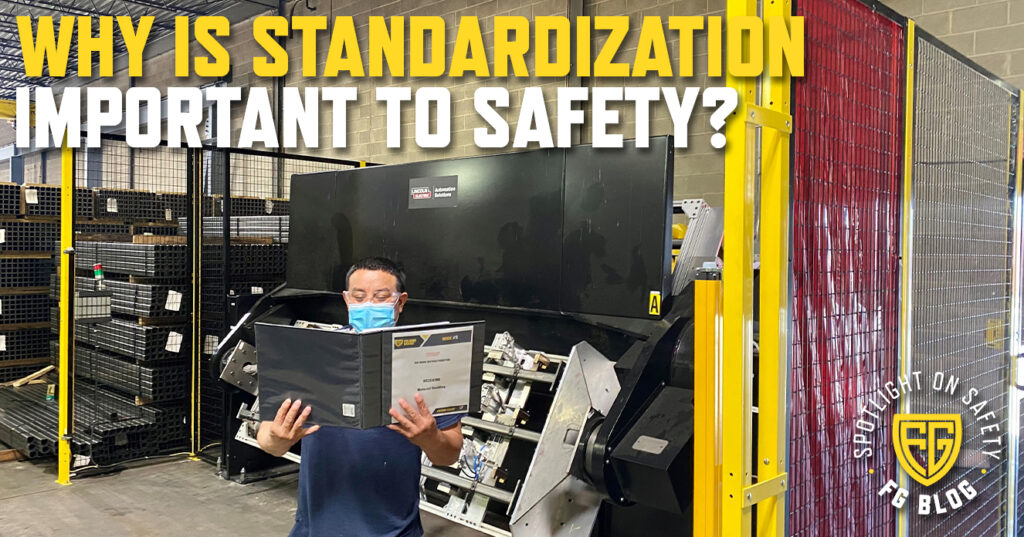Why is Standardization Important to Safety?

It’s time for another Spotlight on Safety, where we discuss safety concerns and best practices that warehouses and manufacturing facilities deal with on a daily basis, and best practices they can use to meet those challenges. This month, we’re taking a look at ISO 9001 certification, and why this certification (or a similar quality control standardization) is important.
ISO Certification & Manufacturing
First, we should probably talk about what ISO actually is: the ISO is the International Organization for Standardization, based out of Geneva, Switzerland. They are described on their website as “an independent, non-governmental international organization with a membership of 165 national standards bodies.”
But what does the ISO have to do with manufacturing businesses? The ISO 9001 is a standard that “sets criteria for a quality management system and is the only standard in the [9000] family that can be certified to.” Essentially, the ISO 9001 creates a system for quality standards and management to streamline operations like Folding Guard’s, and similar industrial manufacturing businesses.
This system sets out to ensure that customers receive consistent, high-quality products. Additionally, standardization is important for maintaining a safe workplace in a warehouse or manufacturing environment.
How can this apply to my manufacturing job?
Imagine you come to work at a manufacturing facility as part of the second shift. You get to your station, and begin your usual process. Maybe you’re welding a wire fence, maybe you’re cutting metal, maybe you’re programming a robot to assemble a large machine. No matter which, you do this job every day and it’s practically muscle memory at this point.
But today, your counterpart from the first shift decided to try a different setting on the tools. Maybe this particular setting was more comfortable for them, maybe they’d made an earlier mistake and needed to adjust the settings to correct it. Either way, your tools are set up differently than normal, and you might not notice before you begin working.
This could lead not only to a manufacturing error, but a possible safety hazard if you’re unprepared or unaware of a change in your workspace. If you’re not aware of everything going on in your workspace, and the functions and settings of each tool you’re using, you’re working unsafely. That’s where ISO 9001 comes in.
Gaining ISO 9001 Certification
Our own Quality Assurance Process Engineer, Jim Marcordes, describes his job by saying “the main part of my job [is making sure we’re all] on the same page, doing the same thing, and [that] both shifts are doing things the same way.” In order to gain ISO 9001 certification, you need to have Process Work Instructions written out for every task in every department.
This way, every person on every shift knows exactly how to set up their tools, measure their products, and perform their tasks the same way, eliminating any unsafe guesswork or miscommunications from the equation. Additionally, as with all safety materials, these Process Work Instructions need to be available in every employee’s native language, so that there are no misunderstandings that could lead to unfortunate accidents.
This is not to say that these processes are set in stone and can’t be updated if someone finds a better way of doing things. Instead it means that any updates will go through the Quality Assurance Process Engineer, so that everyone can be made aware of the changes and be trained to perform them correctly, so that everyone is working within the same processes.
ISO 9001 also requires frequent internal audits, which not only ensure that the tasks are being performed according to the Work Instructions, but that all equipment is meeting standards and safe for use.
The ISO 9001 standards gives employees ownership over their own spaces by requiring frequent equipment checks and measurements. That way, employees can ensure that they are adhering to ISO standards, and make sure that equipment is in good working condition and safe to use.
In short, any company that cares about delivering a consistent, quality product, as well as the continued safety of their employees, should look into ISO 9001 certification, or a similar standardization process. Consistency and vigilance are two of the most important aspects of a safe workspace, and standardization is a great way to incorporate those habits.
